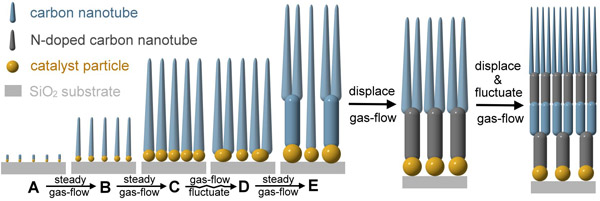Dacheng Wei Yunqi Liu* Lingchao Cao Lei Fu Xianglong Li Yu Wang Gui Yu and Daoben Zhu*2006
VoIndividual carbon nanotubes (CNTs) have been investigated extensively and fabricated as various devices. For a next step as the final goal for applying CNTs in nanoelectronics these individual CNTs with different properties will be integrated to a functional system for realistic applications like integrated circuit. However the integration is still a challenge at present although much attention has been focused there. We have developed a new method (named flow fluctuation method) to solve this problem and controllably synthesized arrays of branched CNTs. The branching architecture can be controlled by flow fluctuation while the compositions over each part are controlled by the component of gas flow (Figure 1). A mechanism of flow fluctuation-promoted coalescence of catalyst particles is proposed to explain the branching process (Figure 2). The method is economical and controllable will provide a hopeful approach to the goal of CNTs-based integrated circuit and be valuable for applications of branched junction in nanoelectronics and producing branched junction of other materials.
Nano Letters 2006 6 186-192.

Figure 1. TEM images of branched CNTs with different composition over each part. a) stem: undoped branch: undoped. b) stem: N-doped branch: N-doped. c) stem: N-doped branch: undoped. d) stem: undoped branch: N-doped.

Figure 2. The scheme depicting the formation of branched junctions. The process is sequential for A to E. At A B C E the gas-flow is steady and at D the gas-flow fluctuates.
, |
